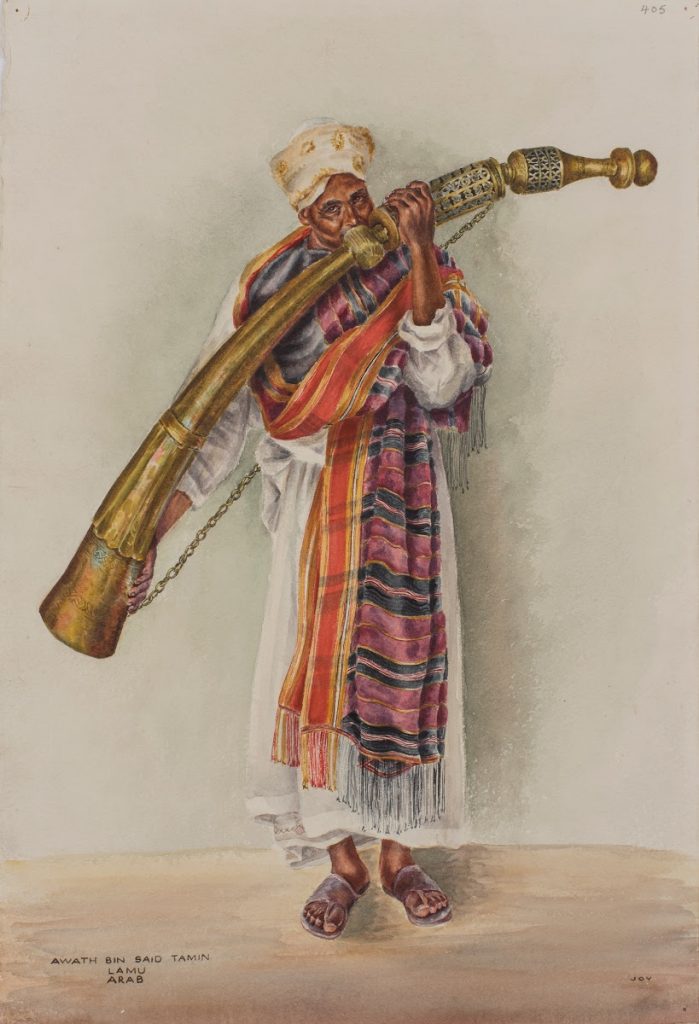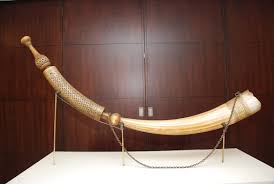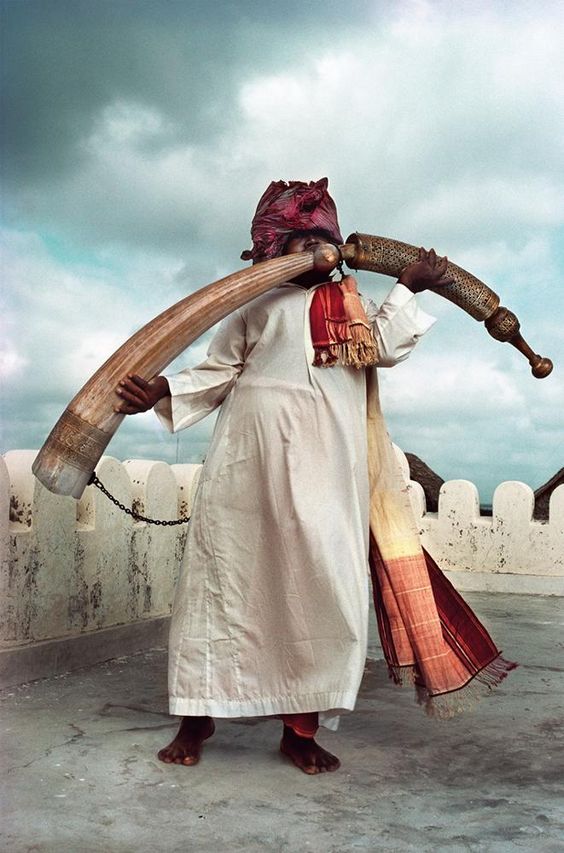Between the 17th and 19th centuries, rulers of city-states on the East African coast used the Siwa as a symbol of authority. The Siwa was a large royal horn made of ivory, metal or wood. Siwa’s belonged to the head of Swahili towns, and only they were the instrument’s sole guardian.
Those who lived in that time believed that the royal regalia held supernatural powers for the reigning monarch. They believed that anyone who heard its sound received blessings, and if anything bad happened to it, then that was a sign of a looming disaster for the ruler.

The Siwa was a wind instrument that was only blown sideways never frontwards, through a hole on the upper and smaller end of the horn. Its bellowing melody would ripple across the land, announcing and celebrating ceremonies such as weddings and circumcisions. The city-state’s political allies could always rent it out for special events, but only if and when the royal family was not using it because they took precedence.
The importance of the Siwa in royal Swahili courts can be depicted by the story of an audacious 17th century Swahili princess, Mwana Darini. Mwana Darini’s father was the sultan of Pate, a city-state located in the heart of the Lamu Archipelago. Upon her father’s death, one of her two brothers inherited the throne, but was soon deposed by their paternal uncle. Some historical accounts state that he went as far as killing both of her brothers to secure his reign. Once in power, the new sultan colluded with the Portuguese to kidnap Mwana Darini’s husband and ship him to Goa.
Mwana Darini and her husband were with child when he was kidnapped, and only a few months passed before Mwana Darini gave birth to a son she named Bwana Tamu Mtoto. She had been informed that her husband would return within 6 months, but 3 years went by, and by then, she knew better than to hold onto false hope.
While still grieving her many losses, Mwana Darini began planning the circumcision of the toddler Bwana Tamu Mtoto. Circumcisions were momentous occasions, and guests from across the archipelago congregated to bear witness to this rite of passage. Mwana Darini was still a member of the royal family and enjoyed the rights that came with her status, so she planned to use the royal Siwa to mark her son’s circumcision ceremony. The sultan heard of Mwana Darini’s plan and spitefully decided to schedule his son’s circumcision on the very day to prevent her from using the sacred horn.
Mwana Darini caught wind of the sultan’s plan, and his audacity angered her. She sent out for Mwenyi Bayayi, a skilled carver. Mwana Darini had her own plan, and he was the one best suited to execute it. She wanted her own Siwa. She wanted a horn far better than that of Pate.
To protect her plan, Mwana Darini employed Mwenyi Bayayi on the strict condition of secrecy. He had no objections, as long as he was paid his 120 riale in a timely manner and provided with quality raw materials of his choosing. They agreed that he would be paid once the Siwa was complete and in her possession, and he got straight to work.
Mwenye Bayayi secretly and diligently toiled on the Siwa. He identified the largest, firmest elephant tusks from the selection he had, running his fingers along their bodies to feel for smooth, consistent grain, and discarding ones with even the most inconspicuous of blemishes. He began crafting the three distinct parts that formed the Siwa. Two of them were decorative pieces attached to the narrow end of the Siwa, and the third one was the main and larger functional section of the horn, made out of the ivory tusk he had selected.
The unveiling of Mwana Darini’s Siwa became a monumental moment to those who were alive to witness it, securing a place in their canonical memories for the remainder of their lives. It was a towering object, over 2 metres in length. The ivory, copper, brass, and wood were bound together ethereally. It appeared impossible that the Siwa’s intricate patterns and inscriptions were the product of a man’s masterly hands. Mwenye Bayayi had produced one of his best work, a Siwa that dwarfed Pate’s official instrument in the eyes of the city-state’s residents.
The Siwa blew life into Mwana Darini’s celebrations. Friends and families danced their hearts out and rained tokens of appreciation on the siwa giving heaps of coins and valuables due to its beauty and the bliss it inspired. Overjoyed, Mwana Darani went to give Mwenye Bayayi his wages. Before paying him the hefty sum they had agreed upon, she gave him the choice to accept the guest’s tokens as payment instead. Mwenye Bayayi opted for the offerings, which undoubtedly turned out to be the better choice.
During this time, one day, officials from the neighbouring island of Lamu asked to rent the king’s Siwa. Seafarers transported the Siwa by boat, but during its journey between the two islands, the dhow carrying the Siwa sank. The royal horn found a new home at the bottom of the sea, and Pate lost its official Siwa.
Mwana Darini expected that royal eyes would turn to her Siwa, and she anticipated that the king would want to take charge of it.
“Give it to us, that we may use it in the towns,” he said.
Mwana Darini refused.
She opted to democratise the use of her Siwa. Mwana Darini freed one of her slaves who knew how to blow the Siwa and proclaimed…
“This man is now the official blower of the horn. He and his descendants. As for his fee, let him be given five riale, a cloth for carrying the horn and ghee for the blower’s consumption. Whoever can afford it should offer him tokens of appreciation whenever they hear the Siwa’s sound.”
From then on, the Siwa blower and his descendants were known as ‘Muyumbe wa Siwa’.
The disappointed sultan went on to sit on the throne without a siwa for seven years. And as the curse would have it, rain did not fall on the land for as long as he was on the throne until he stepped down then.
Many years later, the boy who’s circumcision was graced by the first notes of Mwana Darini’s Siwa became the king of Pate.
Over 300 years later and Mwana Darini’s Siwa is yet to lose its significance. It is now housed at the Nairobi National Museum of Kenya and is still one of the museum’s most prized objects. The museum dates the Siwa’s creation to the year 1668.

Captain Stingad’s accounts state that it was Mwana Darini’s father who ordered the kidnapping of his son-in-law. It also does not mention the killing of the brothers, whereas the widely accepted account does. The author of this piece believes that there may have been a confusion in the recount as many Swahili communities are not recorded to have a local name for paternal uncle and maternal aunt, unlike for maternal uncle and paternal aunt who are referred to as mjomba and shangazi respectively. Therefore the person may have been referring to the paternal uncle as babake – meaning father.

Man blowing a Siwa on a rooftop. Photo from the Lamu Island Collection- Carol Beckwith, Angela Fisher, David Coulson and Nigel Pavitt
Sources
–Capt. C. H. Stigand, The land of Zinj, Constable & Co. London (1913)
–Marina Tolmacheva, The Pate Chronicles (East Lansing, 1992)
–Randall L. Powells, “Reflections on Historiography and Pre-Nineteenth-Century History from the Pate “Chronicles,” HA, 20 (1993)
-5 Reasons Why the Siwa Side-Horn Will Blow Your Mind https://artsandculture.google.com/story/5-reasons-why-the-siwa-side-horn-will-blow-your-mind/tgLyT9gGdDdwKQ











Beautiful history!
This article was the perfect thing to wake up to. Feeling very connected to the islands right now.
Thank you.
this is so interesting! Thank you
You are doing something that I have prayed that it be done periodically in Lamu; that the NMK to be holding talks, presentations, debates etc on Lamu history which is very rich but not known by many of its people.
You have started to do it, digitally! Thank you.
Wow, I’ve loved every bit of it.
Great piece!
Great Article!!
It’s fantastic to learn about stories like this as I am swahili myself, but grew up in England.
This is the kind of history our children need to be taught in school
History is timeless when told through tangible stories…. thank you.
Beautiful story. I have written a children’s book centering on fictional characters in Lamu.